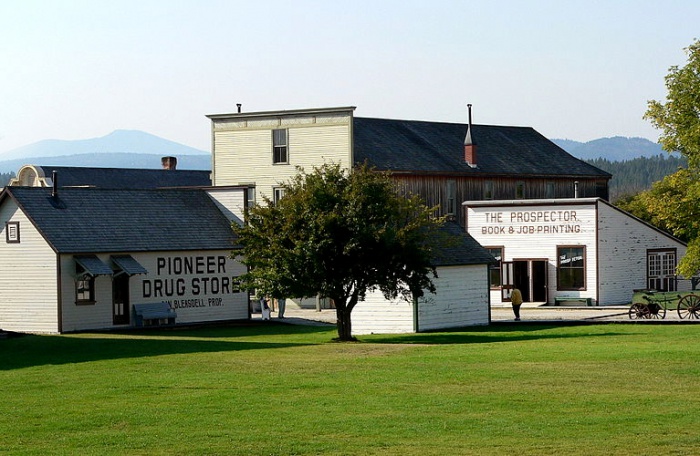 Fort Steele by Wikimedia Commons
Fort Steele by Wikimedia Commons
“Like vanishing dew,
a passing apparition
or the sudden flash
of lighting – already gone –
thus should one regard one’s self.”
Ikkyu
British Columbia is a paradise for all romantic adventurers hunting for vanished or derelict pioneer communities in Canada. Hundreds of ghost towns can be found scattered around BC, waiting for you to explore them. The stories of their fall remain similar from the Alberta border to the far west. Sometimes it was accompanied by a crisis of the mining industry, especially copper, gold, or even asbestos; sometimes the major employer in town went bankrupt; and some towns disappeared after disasters such as floods or big fires. Either way, they remain as quiet evidence of the past lives and dreams that exist no more and they teach us that nothing lasts forever. In today’s post, we’ll introduce some ghost towns that still have lots to offer to potential visitors and don’t just lie in abandoned and hardly accessible ruins.
1. Fort Steele
Every year, more than 80,000 people rush into Fort Steele Heritage Park, located in the heart of the Kootenay Rocky Mountains, to experience the feeling of living in a 19th-century town. The emergence of Fort Steele is closely linked to the gold fever of the 1860s connected to the Wild Horse Creek area. Some say that the lucky ones were able to earn around $50,000 during just one summer, and such news spread more than quickly. Soon, thousands of gold-diggers were flooding Wild Horse Creek and the first buildings were constructed around the local ferry station. By the 1890s, Fort Steele had become a commercial and administrative centre of the region and it boasted more than 1,000 permanent residents.
However, after the mining industry started to decline in the beginning of the 20th century and the decision was made by railway engineers to bypass Fort Steele in favour of the neighbouring Cranbrook, the town would witness its slow downfall over the next decades. By 1960, the town became a virtual ghost town, but luckily, the provincial government decided to purchase the town and declared Fort Steele a historic park following the goal to preserve and present the historic settlement of the town.
Nowadays, Fort Steele is open year-round to tourists and has become one of the top historic settlement sites in the province. While the programming and activities vary by season, visitors can have a walk or explore displays on the self-guided tour of Wild Horse Creek Trail at any time of the year. Wild Horse Creek Trail shouldn’t be missed; it features a historic cemetery and even the remains of mines and mining facilities. Many shops in the town provide souvenirs and everyone can try to get lucky and pan for gold using the only allowed equipment, a pan and a shovel. Some of the upcoming events in Fort Steele include an opportunity to visit clydesdales at Draft Horse Town at the Calgary Stampede and so-called Wild-West Wednesdays. Admission rates vary according to the season but mostly range from $5 to $7. Google map location here
2. Gold Bridge
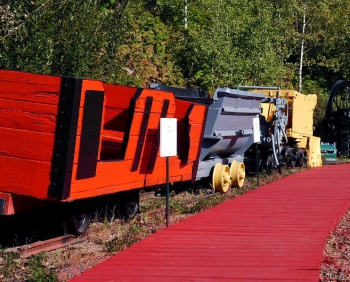
Old Mining Cars in Bralorne by Wikimedia
Commons
Gold Bridge is an excellent example of what could be called semi-ghost town. Nestled in the Bridge River Valley, 105 kilometres west of Lillooet and 300 kilometres north of Vancouver, Gold Bridge survives as a tiny town with a current population of 43 inhabitants. However, it’s important to note that the town itself was constructed as late as the 1930s as an adjunct to the mining towns of Bralorne, Bradian, and Pioneer. Historians agree that this area was probably the richest gold clam in Canada, producing more than $145 million in gold. It was also known as an ‘ethical oasis’ — neither alcohol nor prostitution, both bustling in other mining towns, were tolerated here.
After the mines closed in 1971 and the actual town waned, the area began its slow transition to a tourist destination. Nowadays, visitors can find accommodation in local hotels, motels, and campgrounds or choose one of the numerous small resorts and guest ranches that sprang up in the valley. The main attractions include many original renovated buildings (including a bakery, a church, and the Bralorne-Pioneer mine office) and remnants from mines that are taken care of by the Bralorne Pioneer Museum Society. An interesting museum showcasing the history of the settlements is open from May to October. History seekers can also relive the gold fever by trying to do a little panning for gold. While finding a decent lump of gold is not very easy anymore, the Gold Bridge area is full of jade and even holds a Guinness world record; the biggest jade boulder was found nearby. Besides historical sites, visitors can engage in a plethora of other activities, including hiking on the trails created by gold rush prospectors, fishing, mountain biking, horseback riding, wintertime sports, and much more. Google map location here
3. Barkerville
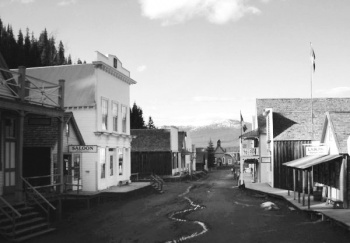 Barkerville by Wikimedia Commons
Barkerville by Wikimedia Commons
Barkerville is one of the most extensive and intriguing mining area museums in Canada. Located due east of Quesnel, near Wells, Barkerville was never a true ghost town; it was continuously populated until it was completely redesigned into a provincial historic site.
In 1862, over just one year, Barkerville experienced an unbelievable influx of newcomers. Thousands of gold-diggers came chasing their luck after they heard the story of Billy Barker (whom the town was named after), who made a fairy-tale fortune just over the summer. At the peak of its success, Barkerville boasted 8,000 residents and was the biggest town north of San Francisco and west of Chicago, with all the things Wild West towns should have: saloons, barbershops, dance halls, and even several businesses of ill repute. It’s also interesting to mention that there were also about 8,000 Chinese settlers, mostly from the province Guangdong, who had a profound influence on the character and culture of the city. The Chinese community built several facilities like Tai Ping (the Peace Room), something like nursing home, the Kwong Lee Company general store, and cabins for miners. However, the prosperity of Barkerville wasn’t meant to last. Already by the mid 1970s, the claims started to peter out and the number of inhabitants kept falling.
Luckily, in 1958, the provincial government stepped in and proclaimed Barkerville a historic site, saving it from inevitable disintegration. Thanks to generous donations, the town looks just as it did at the time of its greatest fame and features over 100 heritage structures, two historic cemeteries, and heaps of precious objects and photographs documenting the history of Barkerville. The local museum also boasts one of the largest Chinese archival collections in Canada. Visitors are also free to take a walk around the town and explore the old mining sites and equipment. In addition to all of that, Barkerville is full of activities and events taking place every day, so tourists can join the morning prayer in the church, witness Chinese school lessons, or attend court sessions reenacting early justice and many more. Admission rates vary according to the age of visitors, but prices range from $4.50 to $13.95. Google map location here
4. Sandon
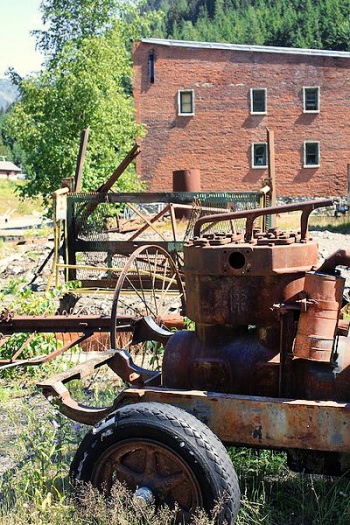 Sandon by Wikimedia Commons
Sandon by Wikimedia Commons
Only 15 full-time residents are left from the 10,000 that used to live in Sandon at the peak of its glory. Now a central site in BC’s famous Valley of the Ghosts located in the Selkirk Mountains, Sandon was founded after the discovery of huge galena ore resources in 1891. While Sandon’s economy was booming and prospectors flocked into the town, smaller communities were established around the area, including the present-day abandoned towns of Cody and Three Forks. Sandon was like a paradise in the wild and dangerous mountains. The town boasted plush hotels, a Miner’s Union Hall with a dance floor and a hall for entertainment, about 851 bordellos, mercantile stores, saloons, banks, and drug stores — more or less everything that a regular town needed. Unfortunately, from there on, the story of Sandon is no different to other ghost towns mentioned here. The price of commodities went down, the yields from mines kept falling every year, and a disastrous fire hit the town in 1990, destroying more than 50 buildings, including an entire business section. The last straw came as a major flood in 1955. The dark side of Sandon’s history is that the government used the area as a Japanese Canadian internment camp during World War II.
Today, the ghostly remnants of the once famed town are surrounded by dark forests. However, scores of buildings and houses remain and some of them have even undergone reconstruction. Visitors can start their trip at the Sandon Museum and Visitor’s Centre, situated in the old Slocan Mercantile Block, and learn more about its history. Some of the other attractions include the Silversmith Powerhouse, the oldest continually operating hydro-electric generating system in Western Canada, the old Sandon Laundry, the Tin Cup Café where you can enjoy a hot coffee on a rainy day, the restored Molly Brown’s Brothel, the Sandon mill yard, and a static CPR steam train display. Even though both railways that ran through the town were dismantled a long time ago, the trails were turned into excellent hiking trails. It’s possible to camp on the site for $10 a night for those who wish to make a several-day trip. Google map location here
5. Ainsworth
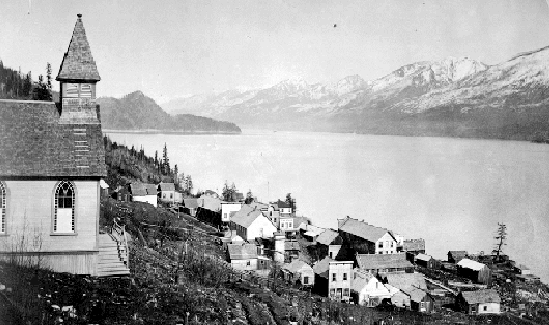 Ainsworth by Wikimedia Commons
Ainsworth by Wikimedia Commons
After the discovery of several high-grade silver samples, prospectors flooded the area of Ainsworth and from 1884 on, signs of mining activity filled every inch of the mountains above the town. The region quickly became famed as the “Silvery Slocan” and lured in more and more settlers. While the town prospered, local businesses boomed, including a number of brothels and hotels, including the Olson Hotel that lasted until 1960. The only thing that played against Ainsworth was its lack of infrastructure. Until 1914, it had no roads, and electrical service was installed as late as 1928. Later on, the town couldn’t survive the shattering decline in mining (although it continued until 1953) and went into quiet hibernation already by the beginning of the 20th century.
However, the decline of the town’s importance as a mining centre gave rise to a brand new business that still keeps the remnants of Ainsworth alive these days: the wonderful hot springs. Probably it’s only thanks to the spas that some of the old buildings have survived and visitors can observe dock and mine remnants. The most valuable part of the preserved historic site is the Ainsworth Cemetery, which is well-kept and taken care of. Nowadays, visitors who come to Ainsworth to relax often find a great deal of Canadian history packed into their vacation experience without realizing it. Ainsworth is located 18 kilometres north of Balfour and 19 kilometres south of Kaslo. Google map location here
http://www.ontarioabandonedplaces.com
Hi Jess,
Thanks for the link! Looks like there is a lively community of explorers. I will definitely give the site a second look.
Cheers,
Jay